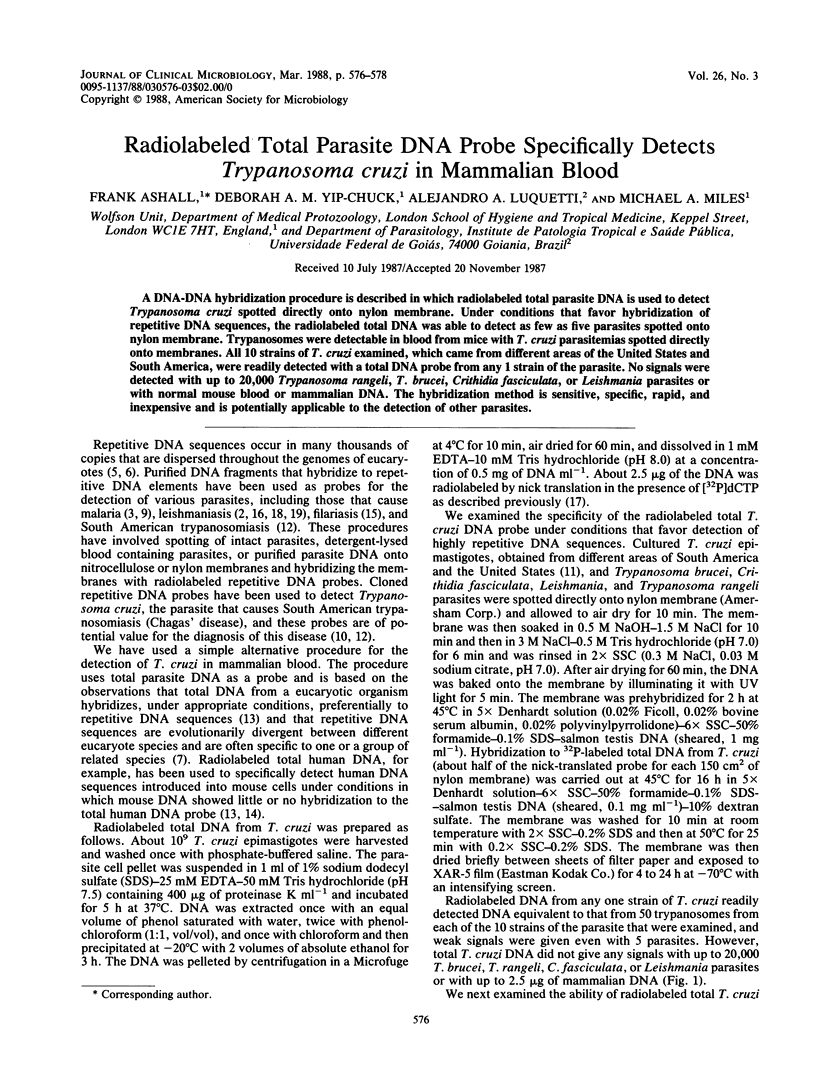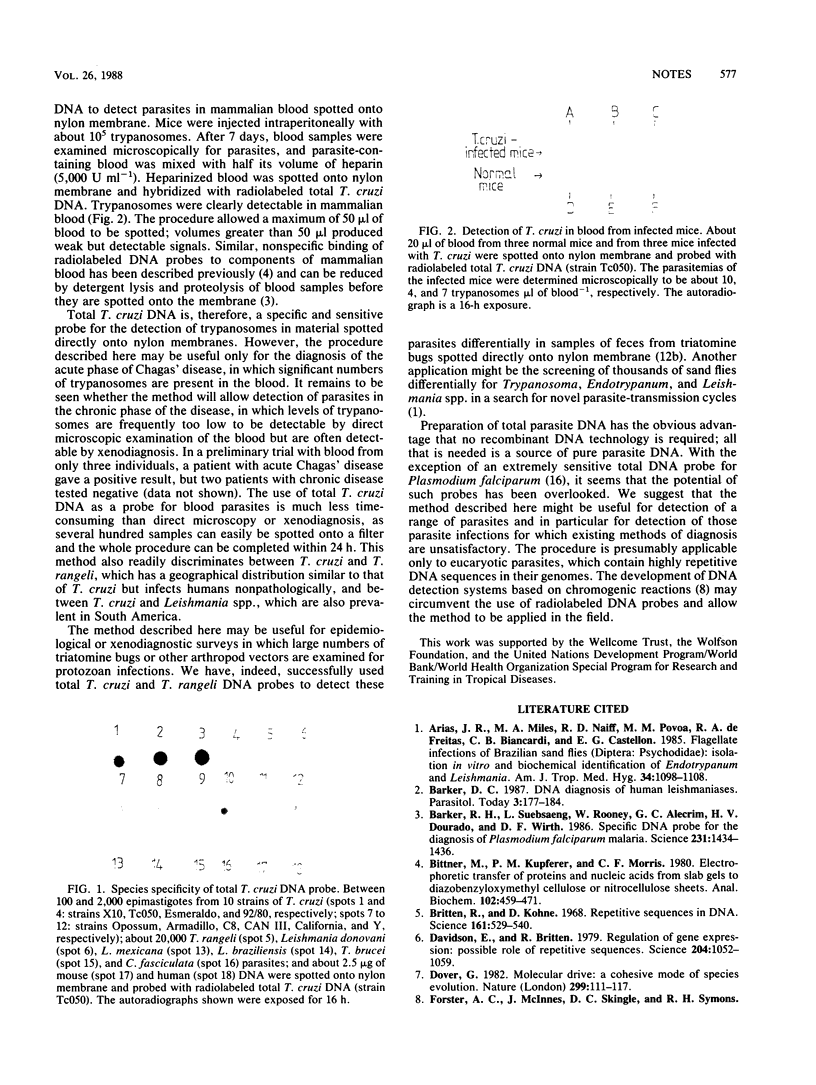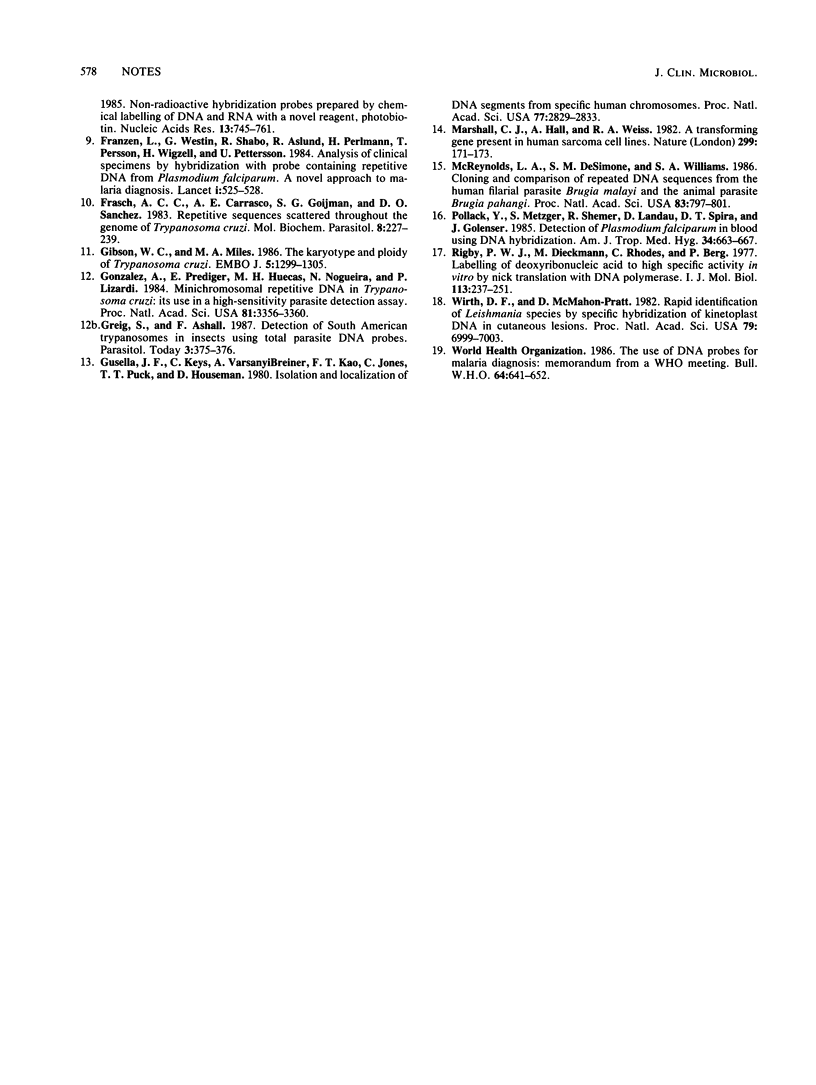Abstract
A DNA-DNA hybridization procedure is described in which radiolabeled total parasite DNA is used to detect Trypanosoma cruzi spotted directly onto nylon membrane. Under conditions that favor hybridization of repetitive DNA sequences, the radiolabeled total DNA was able to detect as few as five parasites spotted onto nylon membrane. Trypanosomes were detectable in blood from mice with T. cruzi parasitemias spotted directly onto membranes. All 10 strains of T. cruzi examined, which came from different areas of the United States and South America, were readily detected with a total DNA probe from any 1 strain of the parasite. No signals were detected with up to 20,000 Trypanosoma rangeli, T. brucei, Crithidia fasciculata, or Leishmania parasites or with normal mouse blood or mammalian DNA. The hybridization method is sensitive, specific, rapid, and inexpensive and is potentially applicable to the detection of other parasites.
Full text
PDF


Images in this article
Selected References
These references are in PubMed. This may not be the complete list of references from this article.
- Arias J. R., Miles M. A., Naiff R. D., Povoa M. M., de Freitas R. A., Biancardi C. B., Castellon E. G. Flagellate infections of Brazilian sand flies (Diptera: Psychodidae): isolation in vitro and biochemical identification of Endotrypanum and Leishmania. Am J Trop Med Hyg. 1985 Nov;34(6):1098–1108. doi: 10.4269/ajtmh.1985.34.1098. [DOI] [PubMed] [Google Scholar]
- Barker D. C. DNA diagnosis of human leishmaniasis. Parasitol Today. 1987 Jun;3(6):177–184. doi: 10.1016/0169-4758(87)90174-8. [DOI] [PubMed] [Google Scholar]
- Barker R. H., Jr, Suebsaeng L., Rooney W., Alecrim G. C., Dourado H. V., Wirth D. F. Specific DNA probe for the diagnosis of Plasmodium falciparum malaria. Science. 1986 Mar 21;231(4744):1434–1436. doi: 10.1126/science.3513309. [DOI] [PubMed] [Google Scholar]
- Bittner M., Kupferer P., Morris C. F. Electrophoretic transfer of proteins and nucleic acids from slab gels to diazobenzyloxymethyl cellulose or nitrocellulose sheets. Anal Biochem. 1980 Mar 1;102(2):459–471. doi: 10.1016/0003-2697(80)90182-7. [DOI] [PubMed] [Google Scholar]
- Britten R. J., Kohne D. E. Repeated sequences in DNA. Hundreds of thousands of copies of DNA sequences have been incorporated into the genomes of higher organisms. Science. 1968 Aug 9;161(3841):529–540. doi: 10.1126/science.161.3841.529. [DOI] [PubMed] [Google Scholar]
- Davidson E. H., Britten R. J. Regulation of gene expression: possible role of repetitive sequences. Science. 1979 Jun 8;204(4397):1052–1059. doi: 10.1126/science.451548. [DOI] [PubMed] [Google Scholar]
- Dover G. Molecular drive: a cohesive mode of species evolution. Nature. 1982 Sep 9;299(5879):111–117. doi: 10.1038/299111a0. [DOI] [PubMed] [Google Scholar]
- Franzén L., Westin G., Shabo R., Aslund L., Perlmann H., Persson T., Wigzell H., Pettersson U. Analysis of clinical specimens by hybridisation with probe containing repetitive DNA from Plasmodium falciparum. A novel approach to malaria diagnosis. Lancet. 1984 Mar 10;1(8376):525–528. doi: 10.1016/s0140-6736(84)90929-2. [DOI] [PubMed] [Google Scholar]
- Frasch A. C., Carrasco A. E., Goijman S. G., Sanchez D. O. Repetitive sequences scattered throughout the genome of Trypanosoma cruzi. Mol Biochem Parasitol. 1983 Jul;8(3):227–239. doi: 10.1016/0166-6851(83)90045-2. [DOI] [PubMed] [Google Scholar]
- Gibson W. C., Miles M. A. The karyotype and ploidy of Trypanosoma cruzi. EMBO J. 1986 Jun;5(6):1299–1305. doi: 10.1002/j.1460-2075.1986.tb04359.x. [DOI] [PMC free article] [PubMed] [Google Scholar]
- Gonzalez A., Prediger E., Huecas M. E., Nogueira N., Lizardi P. M. Minichromosomal repetitive DNA in Trypanosoma cruzi: its use in a high-sensitivity parasite detection assay. Proc Natl Acad Sci U S A. 1984 Jun;81(11):3356–3360. doi: 10.1073/pnas.81.11.3356. [DOI] [PMC free article] [PubMed] [Google Scholar]
- Greig S., Ashall F. Detection of South American trypanosomes in insects using total parasite DNA probes. Parasitol Today. 1987 Dec;3(12):375–376. doi: 10.1016/0169-4758(87)90247-x. [DOI] [PubMed] [Google Scholar]
- Gusella J. F., Keys C., VarsanyiBreiner A., Kao F. T., Jones C., Puck T. T., Housman D. Isolation and localization of DNA segments from specific human chromosomes. Proc Natl Acad Sci U S A. 1980 May;77(5):2829–2833. doi: 10.1073/pnas.77.5.2829. [DOI] [PMC free article] [PubMed] [Google Scholar]
- Marshall C. J., Hall A., Weiss R. A. A transforming gene present in human sarcoma cell lines. Nature. 1982 Sep 9;299(5879):171–173. doi: 10.1038/299171a0. [DOI] [PubMed] [Google Scholar]
- McReynolds L. A., DeSimone S. M., Williams S. A. Cloning and comparison of repeated DNA sequences from the human filarial parasite Brugia malayi and the animal parasite Brugia pahangi. Proc Natl Acad Sci U S A. 1986 Feb;83(3):797–801. doi: 10.1073/pnas.83.3.797. [DOI] [PMC free article] [PubMed] [Google Scholar]
- Pollack Y., Metzger S., Shemer R., Landau D., Spira D. T., Golenser J. Detection of Plasmodium falciparum in blood using DNA hybridization. Am J Trop Med Hyg. 1985 Jul;34(4):663–667. doi: 10.4269/ajtmh.1985.34.663. [DOI] [PubMed] [Google Scholar]
- Rigby P. W., Dieckmann M., Rhodes C., Berg P. Labeling deoxyribonucleic acid to high specific activity in vitro by nick translation with DNA polymerase I. J Mol Biol. 1977 Jun 15;113(1):237–251. doi: 10.1016/0022-2836(77)90052-3. [DOI] [PubMed] [Google Scholar]
- Wirth D. F., Pratt D. M. Rapid identification of Leishmania species by specific hybridization of kinetoplast DNA in cutaneous lesions. Proc Natl Acad Sci U S A. 1982 Nov;79(22):6999–7003. doi: 10.1073/pnas.79.22.6999. [DOI] [PMC free article] [PubMed] [Google Scholar]




